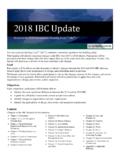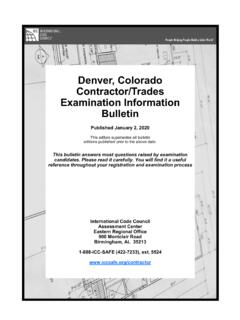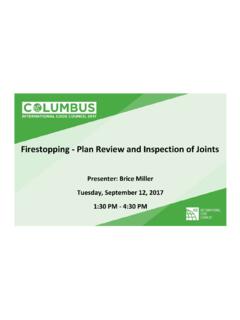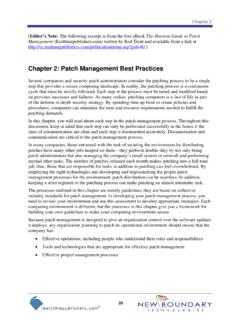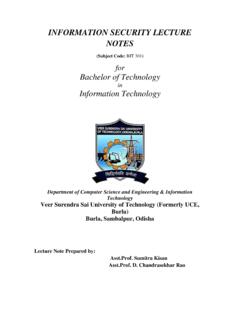Transcription of IBC 10-1 electrical room requirements - iccsafe.org
1 IBC 10-1 electrical room requirements Egress based on use. The numbers, types, and locations of exits or access to exits shall be provided in the uses described in Sections through Boiler, incinerator and furnace rooms. Two exit access doorways are required in boiler, incinerator and furnace rooms where the area is over 500 square feet (46 m2) and any fuel-fired equipment exceeds 400,000 British thermal units (Btu) (422 000 KJ) input capacity. Where two exit access doorways are required, one is permitted to be a fixed ladder or an alternating tread device. Exit access doorways shall be separated by a horizontal distance equal to one-half the length of the maximum overall diagonal dimension of the room .
2 Refrigeration machinery rooms. Machinery rooms larger than 1,000 square feet (93 m2) shall have not less than two exits or exit access doorways. Where two exit access doorways are required, one such doorway is permitted to be served by a fixed ladder or an alternating tread device. Exit access doorways shall be separated by a horizontal distance equal to one-half the maximum horizontal dimension of the room . All portions of machinery rooms shall be within 150 feet (45 720 mm) of an exit or exit access doorway. An increase in exit access travel distance is permitted in accordance with Section Exit and exit access doorways shall swing in the direction of egress travel, regardless of the occupant load served.
3 Exit and exit access doorways shall be tight fitting and self-closing. Refrigerated rooms or spaces. Rooms or spaces having a floor area larger than 1,000 square feet (93 m2), containing a refrigerant evaporator and maintained at a temperature below 68 F (20 C), shall have access to not less than two exits or exit access doorways. Exit access travel distance shall be determined as specified in Section , but all portions of a refrigerated room or space shall be within 150 feet (45 720 mm) of an exit or exit access doorway where such rooms are not protected by an approved automatic sprinkler system. Egress is allowed through adjoining refrigerated rooms or spaces.
4 Exception: Where using refrigerants in quantities limited to the amounts based on the volume set forth in the International Mechanical Code. electrical rooms. electrical rooms shall be provided with exit or exit access doorways in accordance with Section of NFPA 70 for electrical equipment rated 1000V or less, and Section of NFPA 70 for electrical equipment rated over 1000V. Group I-4 means of egress. Group I-4 facilities, rooms or spaces where care is provided for more than 10 children that are 21/ 2 years of age or less, shall have access to not less than two exits or exit access doorways. Vehicular ramps. Vehicular ramps shall not be considered as an exit access ramp unless pedestrian facilities are provided.
5 Groups R-3 and R-4. Where Group R-3 occupancies are permitted by Section to be protected by an automatic sprinkler system installed in accordance with Section , the exit access travel distance for Group R-3 shall not be more than 125 feet (38 100 mm). Where Group R-4 occupancies are permitted by Section to be protected by an automatic sprinkler system installed in accordance with Section , the exit access travel distance for Group R-4 shall not be more than 75 feet (22 860 mm). Doors. Means of egress doors shall meet the requirements of this section. Doors serving a means of egress system shall meet the requirements of this section and Section Doors provided for egress purposes in numbers greater than required by this code shall meet the requirements of this section.
6 Means of egress doors shall be readily distinguishable from the adjacent construction and finishes such that the doors are easily recognizable as doors. Mirrors or similar reflecting materials shall not be used on means of egress doors. Means of egress doors shall not be concealed by curtains, drapes, decorations or similar materials. Door operations. Except as specifically permitted by this section, egress doors shall be readily openable from the egress side without the use of a key or special knowledge or effort panic and fire exit hardware . Swinging doors serving a Group H occupancy and swinging doors serving rooms or spaces with an occupant load of 50 or more in a Group A or E occupancy shall not be provided with a latch or lock other than panic hardware or fire exit hardware .
7 Exceptions: 1. A main exit of a Group A occupancy shall be permitted to be locking in accordance with Section , Item 2. 2. Doors provided with panic hardware or fire exit hardware and serving a Group A or E occupancy shall be permitted to be electrically locked in accordance with Section or Installation. Where panic or fire exit hardware is installed, it shall comply with the following: 1. panic hardware shall be listed in accordance with UL 305. 2. Fire exit hardware shall be listed in accordance with UL 10C and UL 305. 3. The actuating portion of the releasing device shall extend not less than one-half of the door leaf width.
8 4. The maximum unlatching force shall not exceed 15 pounds (67 N). Balanced doors. If balanced doors are used and panic hardware is required, the panic hardware shall be the push-pad type and the pad shall not extend more than one-half the width of the door measured from the latch side. For reference Sections and from the 2017 NEC: Part II. 1000 Volts, Nominal, or Less Spaces About electrical Equipment. Access and working space shall be provided and maintained about all electrical equipment to permit ready and safe operation and maintenance of such equipment. (C) Entrance to and Egress from Working Space. (1) Minimum Required.
9 At least one entrance of sufficient area shall be provided to give access to and egress from working space about electrical equipment. (2) Large Equipment. For equipment rated 1200 amperes or more and over m (6 ft) wide that contains overcurrent devices, switching devices, or control devices, there shall be one entrance to and egress from the required working space not less than 610 mm (24 in.) wide and m (61 2 ft) high at each end of the working space. A single entrance to and egress from the required working space shall be permitted where either of the conditions in (C)(2)(a) or (C)(2)(b) is met. (a) Unobstructed Egress. Where the location permits a continuous and unobstructed way of egress travel, a single entrance to the working space shall be permitted.
10 (b) Extra Working Space. Where the depth of the working space is twice that required by (A)(1), a single entrance shall be permitted. It shall be located such that the distance from the equipment to the nearest edge of the entrance is not less than the minimum clear distance specified in Table (A)(1) for equipment operating at that voltage and in that condition. (3) Personnel Doors. Where equipment rated 800 A or more that contains overcurrent devices, switching devices, or control devices is installed and there is a personnel door(s) intended for entrance to and egress from the working space less than m (25 ft) from the nearest edge of the working space, the door(s) shall open in the direction of egress and be equipped with listed panic hardware .
